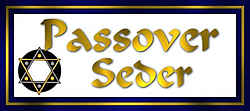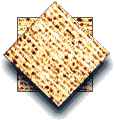Symbolic significants
Passover foods:
horseradish for bitter bondage
salt water for tears
charoset, apples and nuts, for brick mortar
matzo for unleavened bread of hasty departure
ten drops of wine for the ten plagues
shankbone for the lamb.
parsley which symbolizes newness of life
roasted egg, a symbol of the sacrifice offering. It
reminds us that in Messiah all tears of anguish will be replaced
with tears of joy;
![]()
The afikomen In the ceremony the middle loaf is removed, broken in two, wrapped in a linen cloth, and hidden . After a period of time it is removed from its hiding place, unwrapped from the linen cloth, and pieces are broken to distribute to each one participating in the Passover. The unleavened bread had to be striped. The body of Messiah was also striped by way of the roman whip at the scourging. Concerning the stripes, Isaiah 53 said, with these stripes we are healed. The bread also had to be pierced. The body of Messiah was also pierced by the nails in His hands and feet and by the spear thrown into His side. Concerning the piercing, Zechariah 12:20 say, "They shall look unto him whom they have pierced." By being striped, pierced and unleavened, the Jewish Passover bread is a unique picture of the body of Messiah. (By Frank Potter The Symbols of Passover The Chosen People Magazine April 1990 )

